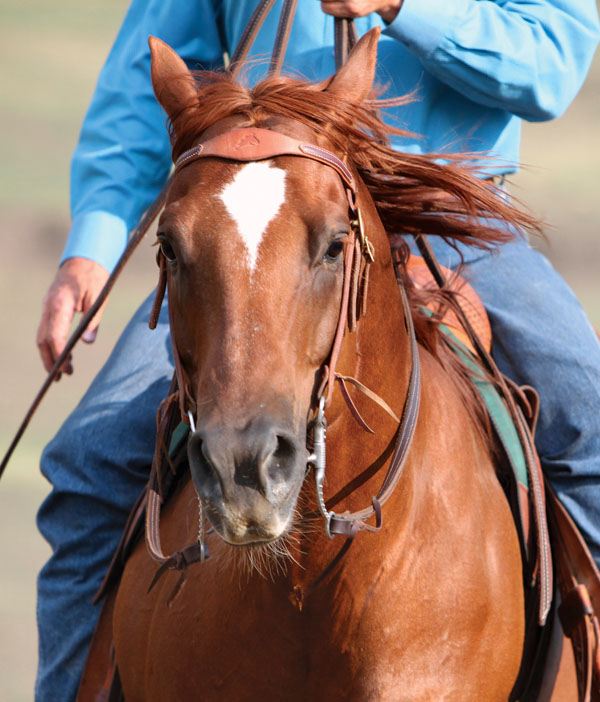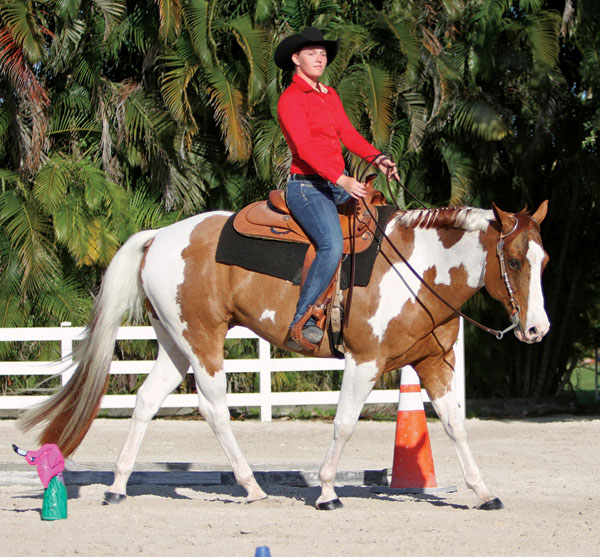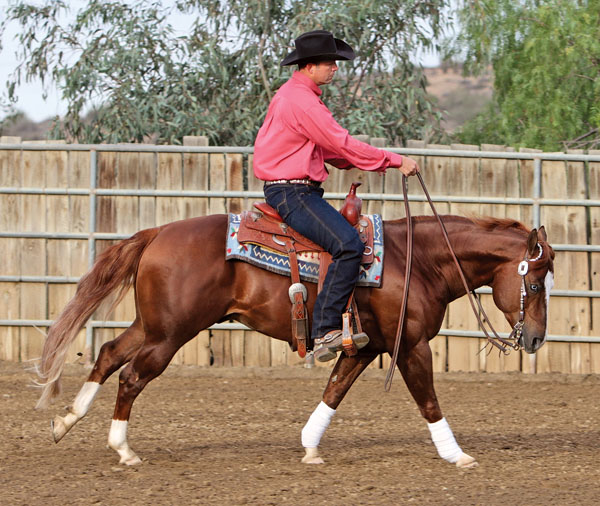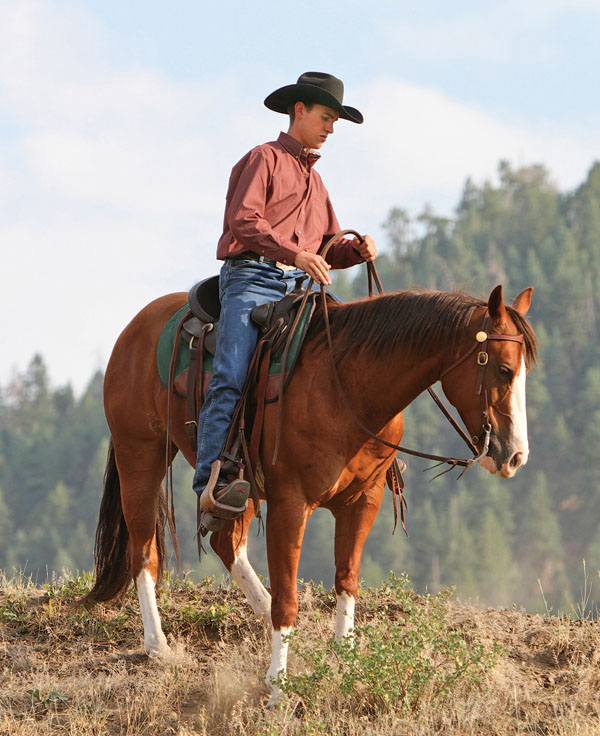Trigger is tired, but you don’t know why. Sure, it’s been a busy week of showing, but you’ve been working like crazy to get him fit. He’s worked six days a week, and spends an hour every day on the hot walker. When it came time for the most important class of the show, Trigger just plain ran out of gas. He was grouchy, lazy, and didn’t want to work. “Is he sick?” you wonder. “Maybe I should call the vet!”
[MORE: GET YOUR BARREL-RACING HORSE IN SHAPE]

Maybe Trigger’s just plain tired! With all of your efforts to get him fit, did you remember to give him a break? If you’re an overachiever with a serious goal in mind, it’s easy to believe that the harder you work, the better your horse will be. But more’s not always better, and it sounds as if Trigger might’ve fallen victim to a classic conditioning faux pas—overtraining. Does that mean you should just let him sit around?
Unfortunately, “not enough” can be a problem too. That’s what makes conditioning so complicated.
In this article, I’ll review core conditioning principles and how to apply them. Then I’ll explore five of the most common conditioning mistakes horse owners make and the problems they cause, plus offer better strategies to use instead.
Conditioning 101
What’s conditioning? In this case, it describes work you do with your horse to improve his physical ability to perform, whether it’s for trail riding, working cows, or running barrels. Different activities require different types of conditioning, but no matter what your horse does for a living, proper conditioning will both improve his capacity for exercise (he can work harder, longer) and reduce the chance that he’ll be injured.
When your horse exercises, energy is initially produced in his body through pathways that require oxygen, called aerobic energy. Once that oxygen is used up, your horse turns to an alternative form of energy that doesn’t require oxygen to produce, called anaerobic energy. Anaerobic energy requires approximately 10 times the amount of fuel to produce as aerobic energy. When your horse begins to depend on anaerobic energy sources, he’ll soon become fatigued.
Conditioning increases your horse’s aerobic capacity, meaning he’ll use oxygen for a longer period of time before he shifts to anaerobic energy production. This occurs by increasing the amount of blood his heart can pump to deliver oxygen to his muscles, as well as by increasing the actual volume of his blood and the hemoglobin (oxygen-carrying substance) it contains. With proper conditioning, your horse’s muscle cells will also increase in size to make room for more energy-production factories, and the density of capillaries (small blood vessels) in his muscles will increase to allow more blood to flow. All of these factors combine for optimal oxygen efficiency, making more fuel available for work.
Aerobic capacity isn’t the only thing that changes with conditioning. Improved blood flow also means waste products that build up during exercise and contribute to fatigue will be cleared more easily from your horse’s system. Simply put, he’ll not only have more energy, he’ll fatigue more slowly.
Musculoskeletal effects also play an important role in any fitness plan. With careful work, your horse’s tendons and ligaments become stronger and more elastic, cartilage that lines the joints becomes thicker, joints become more flexible, and joint lubrication improves. Even his bones will become stronger over time. Moreover, sport-specific training means your horse will develop more of the types of muscle fibers needed for his job. For example, sprint training (part of the conditioning plan for a sprinter like a barrel racer, rope horse, or race horse) will increase the number of fast-twitch fibers—muscle fibers that use primarily anaerobic metabolism and produce short bursts of strength and speed.
Finally, thermoregulation (the ability to control body temperature) improves with conditioning. Your horse dissipates heat through two primary mechanisms—breathing and sweating. With conditioning, his lung capacity improves, which will allow him to lose heat more efficiently through his breathing. His increased blood volume helps him sweat without becoming dehydrated, and those same capillaries in muscles that allow for oxygen delivery also help carry blood to the surface of his body to help cool him down.
So what does a conditioning program need to achieve these goals? The following three basic principles apply.
Step-wise training: All carefully designed conditioning programs depend on gradual, systematic increases in stress to body systems. Typically, this begins with a period of “backgrounding” or long, slow distance work. Backgrounding begins with 20 to 30 minutes of walking and trotting at least every other day for six to eight weeks to provide a solid foundation for other work. When additional exercise is added, it should gradually increase in intensity, with periods of rest included to prevent over-training.
Specificity of exercise: Exercises specific to your horse’s work demands are also important—again with gradual increases in intensity. For a barrel horse, this might start with one or two short sprints two to three times weekly, gradually increasing to a full barrel pattern after several weeks. For a reining horse, this could include work on individual maneuvers such as stops or spins before introducing a series of maneuvers. For a trail horse, it might involve starting with short trail rides over easy terrain, then gradually increasing the length and difficulty of the trail.

Acclimatization to conditions: No matter how fit your horse is at home, he’ll still be in trouble if he has to hit it hard when it’s hotter, colder, drier, wetter, or higher altitude than he’s conditioned for. The final step in your horse’s conditioning program is to consider the environment where he’ll face his highest work demands. If you’re attending a show in Arizona in December, and hauling in from Minnesota, plan to arrive at least a week or two ahead of time to allow him to adapt. Or if you plan to hit the mountains for a weeklong trail-riding extravaganza, plan on a regular schedule of shorter mountain rides as part of his conditioning plan.

Does getting your horse fit seem more complicated than you thought? You’re not alone. Take a look at the following common conditioning flubs and learn how to avoid them.
Missed the Point
Your goal: You hope to take your horse on a five-day trail ride with a group of friends. You’ll be out on the trails for several miles each day in a mountainous area, so your horse will need to navigate some fairly steep hills. It’s also likely to be hot.
Prep plan: You have a busy life—that’s why you’re excited about the trip! You generally ride after work, about four days a week, mostly in an arena. You know your horse will need some extra conditioning, so you make a commitment to get to the barn five days a week during the month before your trip. You make sure he’s working for at least an hour at every ride—that should be plenty of work to get him fit.
What’s wrong: Your horse may be fit for arena work in the cool evening hours, but he’s likely to struggle mightily with the hot daytime temperatures, hills, and multiple-hour rides required on your extended ride. You put in the effort to get him fit and have a good start on backgrounding, but forgot to tailor your conditioning program to the specific demands he’ll face on this long trail ride. You also failed to give him time to acclimate.
Health alert! Your horse could easily become dehydrated in the heat, putting him at risk for colic or a tie-up episode. His joints, tendons, and ligaments are at increased risk for injury because he’s faced with footing conditions and work demands he’s not prepared for. Finally, long days of carrying a saddle could put him at risk for cinch galls or other tack-related injuries.
Fix it: Your five-day-a-week at-home plan is great and will definitely help to give your horse a good conditioning base. Try to include at least a weekly (twice weekly would be better) trail ride in conditions that mimic what he’ll experience on your longer ride, including heat, higher altitude, and uneven ground. With your busy life it might not be possible to take your horse to the ride location a week ahead of time to acclimate, plan to gradually increase each ride’s difficulty.
Too Much Too Soon
Your goal: You’re so excited about your weanling filly. She’s beautiful, sweet, and moves like a dream. You’ve never had such a quality youngster in your barn, and can hardly wait to hit the halter and longe-line futurities next year.

Prep plan: You carefully formulate her diet with plenty of alfalfa, a high-energy concentrate mix, and the vitamins she needs to grow. You know she has to be fit and strong to show well on the longe line, so you plan a schedule of longeing five days each week.
What’s wrong: Your filly is just a baby—with soft bones, immature cartilage, and a child-like mind. While a little bit of work to “teach her the ropes” will be required, conditioning too hard for halter and longe-line futurities is a recipe for disaster. Overfeeding and a rigorous conditioning schedule are likely to turn beautiful and sweet into fat, grouchy, and sore. If you really push too hard, your perfect filly could easily become a permanently broken adult.
Health alert! Overfeeding can contribute to a host of developmental orthopedic disorders including both epiphysitis (inflamed growth plates), osteochondrosis (abnormal bone development that can result in serious joint problems), and contracted tendons. Overwork puts even more stress on immature bones, joints, and soft tissues that can make problems even worse. Finally, a rigorous training schedule for a baby is akin to putting your gifted 8-year-old into college courses—it may simply blow her mind.
Fix it: Prepare your baby for halter and longe-line classes with a perfect balance of training and rest. Most successful longe-line trainers don’t even teach their babies to longe until they’re close to a year of age—and once they’ve learned the basic skill, there’s no need to drill. Instead, youngsters often live outside where their day-to-day activity is all the exercise they really need. Three months before the competitions begin, 10 to 15 minutes of work three days a week will get your filly plenty fit without causing stress. A carefully balanced diet, often including a mix of alfalfa and grass hay with a ration balancer, will ensure that she gets the nutrients she needs, but won’t be overfed. And finally, recognize that some babies just don’t want to do it. If yours needs too much work to train, you’d be wise to save her for her riding years instead.
Over-Conditioning
Your goal: You just finished penciling out your show season, and this is the year you get to go for it! You’ll start in spring with a series of local schooling shows to get your horse in shape, then plan to hit the big-time shows so you can accumulate points to qualify for a year-end show or title. You’ve been saving for years, and you’re prepared to log however many miles it takes to reach your goal. It’s a dream come true!
Prep plan: You know this rigorous plan will be hard on your horse, and that he’ll have to be in the best physical shape of his life to hold up for the long, hard season ahead. You plan to begin with a schedule of gradually increasing long, slow distance work. By March you’ll be able to add three days of vigorous training. And you’ll make sure he spends at least an hour each day walking on the hot walker. Your horse is going to be fit!
What’s wrong: You make it to the first horse show, and your horse is fit, all right. So fit, in fact, that you have to longe him for an hour every morning just to get him quieted down enough to make it to the ring. By your fourth show, he seems a little sore. By number six, he decides he doesn’t want to play—he balks at the gate, wears a sour face around the ring, and when it comes time to pick up the lope he flat says “no.”
Your horse is over-trained. Although your intentions were good, you forgot to temper your aggressive conditioning plan and give your horse a break.
Health alert! First and foremost, over-conditioning leads to mental burnout. An exhausted horse won’t be at his best. And if he’s so fit he requires the “longe-until-dead” routine to be quiet enough to compete, he’s also at risk for musculoskeletal problems such as tendon and ligament strains or degenerative joint disease from excessive stress.
Fix it: Give him a break! Allow your horse at least one day off each week, with longer breaks of several days after competitions, long hauls, or vigorous training. Once you’ve achieved a solid base of fitness, he shouldn’t need many hard training days between events. Consider a trail ride instead.
Under-Conditioning
Your goal: You don’t have a strict agenda for your horse. You like to trail ride on occasional weekends with your friends. You usually turn him out for winter months, then knock off the mud when it’s time to ride.
Prep plan: Your horse is an older Quarter Horse gelding, and he’s always been an easy keeper. He’s well behaved, and doesn’t need much work. He’s never been anything but a perfect gentleman on the trail. You really don’t think you need much of a plan—when summer comes he can come in from the pasture and will be ready to go!
What’s wrong: After your first ride of the season, your poor horse can hardly walk. He shuffles out of his stall, and looks plain pitiful standing on the crossties. Problem is, your horse really does need a bit of fitness even for those light trail rides—especially as he’s getting older.
Health alert! Imagine how you feel the first time you hit the gym after months of exercise avoidance. Your horse’s muscles get sore. Your unfit horse is also at risk for tying-up and musculoskeletal injuries like tendon and ligament strains.
Fix it: It doesn’t take much to give your weekend warrior a little bit of fitness to help him do his job. An initial period of backgrounding, and three to four light work days each week should be enough to keep him fit for light trail rides.
Forgot the Foundation
Your goal: Your horse has been laid off for the winter, and now it’s time to go back to work. You ride mostly for fun, taking a couple of lessons a month from a local trainer and trail riding from time to time.
Prep plan: You know you need to start your horse slowly so he won’t get sore, and usually ease back into regular riding with several weeks of walking and trotting until your horse starts to feel stronger. After a month or two, he should be ready for a lesson, and perhaps a light trail ride.
What’s wrong: Your casual conditioning plan sounds great. You’ve included a little bit of backgrounding, and the addition of a lesson and a light trail ride after a month or two is the perfect way to add that “sport-specific” conditioning to his work. But did you remember to consider his basic care? While you’re knocking of the winter mud, don’t forget to factor in his feeding plan, foot care, and basic veterinary needs.
Health alert! If your horse’s feet are soft or out of balance, he can quickly go lame when he starts to exercise. And dental problems can easily lead to mouth ulcers or other injuries when you put that bit back in his mouth.
Fix it: Always remember that good conditioning begins with good overall health. Start by booking an appointment with your farrier to get your horse’s feet in shape, then have your vet check basic health-care needs like routine dentistry, vaccinations, deworming, and feeding adjustments.






